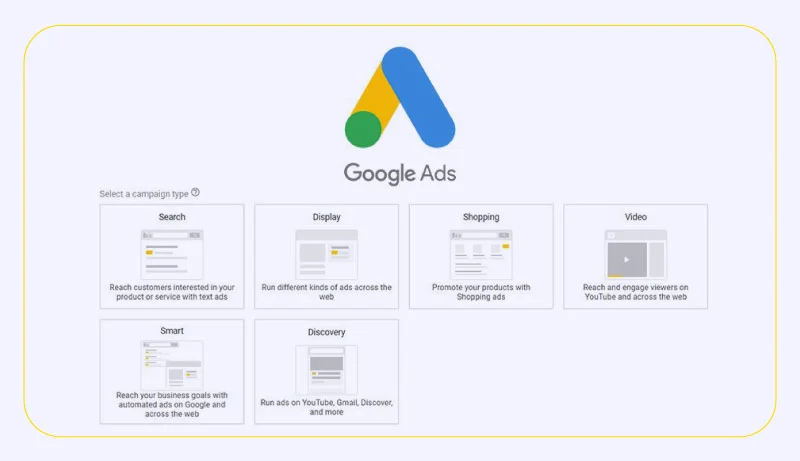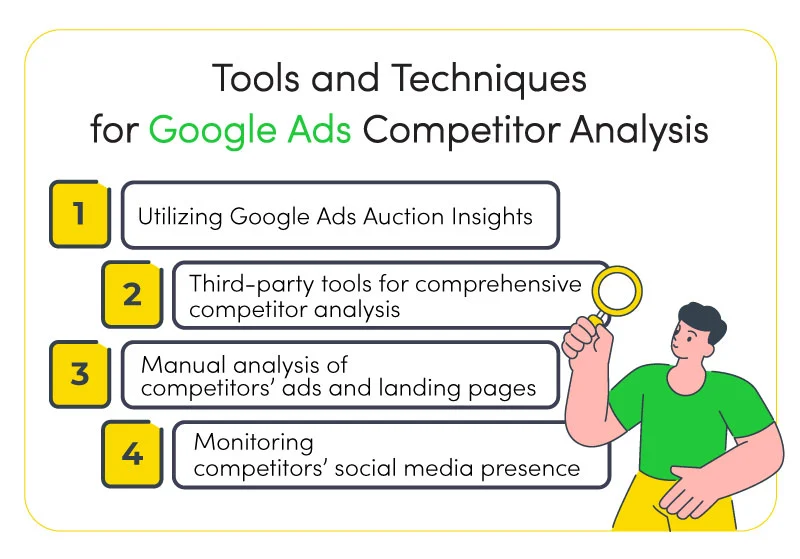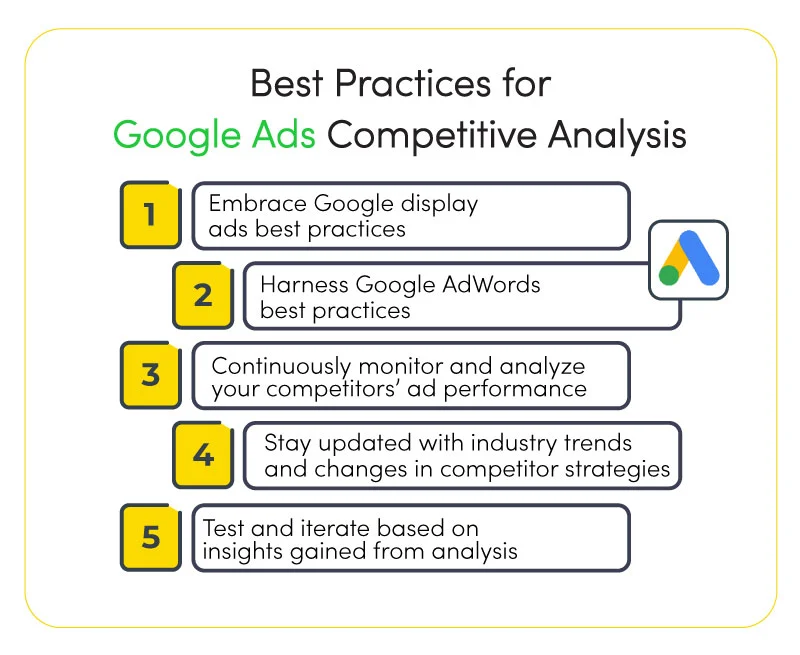In the highly competitive world of online advertising, gaining a strategic advantage is crucial for the success of your Google Ads campaigns. To achieve this, understanding your competitors’ strategies and performance becomes paramount. This is where Google Ads competitor analysis comes into play. By delving deep into the tactics and approaches adopted by your rivals, you can uncover valuable insights that can inform your own advertising strategies and help you stand out in the digital landscape.

In this article, we will explore the significance of conducting a comprehensive Google Ads competitor analysis, the key metrics and factors to consider, the tools and techniques available, and best practices to keep you at the forefront of the game. With Google Ads competitor analysis as your ally, you can unlock a world of possibilities and elevate your advertising efforts to new heights.
Key Metrics and Factors for Google Ads Competitor Analysis
When it comes to outsmarting your competition in the realm of Google Ads, knowledge is power. Understanding how your competitors are performing and what strategies they’re employing can provide you with valuable insights to optimize your own campaigns. So, how do you check your competitors’ Google Ads? Let’s explore the key metrics and factors that can help you unlock the secrets of your rivals’ success.
- Identifying relevant competitors in the industry: The first step in a competitor analysis is identifying who your true contenders are. Look for businesses targeting the same audience or offering similar products/services. Understanding the competitive landscape helps you focus your analysis on the most relevant players in the field.
- Analyzing competitors’ ad performance metrics: To gain a comprehensive understanding of your competitors’ Google Ads performance, you need to dive into their metrics. Start by examining key indicators such as click-through rate (CTR), conversion rate, and average position. By comparing these metrics with your own, you can gauge how well your ads are performing relative to your competitors.

- Evaluating competitors’ targeting strategies: Successful targeting is the cornerstone of effective Google Ads campaigns. Study your competitors’ audience targeting methods, including their use of demographics, interests, and remarketing. Additionally, analyze their keyword selection and ad placements to gain insights into their strategy.
- Assessing competitors’ ad messaging and creative approaches: The ad copy and creative elements play a pivotal role in capturing the attention of potential customers. Take a close look at your competitors’ headlines, descriptions, and call-to-action to identify the messaging strategies that resonate with their target audience. This information can inspire improvements to your own ad content.
- Examining competitors’ landing pages and user experience: A compelling ad is just the beginning; the landing page experience determines whether visitors convert into customers. Analyze your competitors’ landing pages to understand their design, content, and overall user experience. By identifying elements that contribute to a positive user journey, you can enhance your own landing pages to increase conversion rates.
How to check your competitors’ Google Ads involves a multi-faceted approach that combines metrics analysis, creative assessment, and user experience evaluation. By delving into these factors, you gain valuable insights into the strategies your rivals are employing, allowing you to fine-tune your own campaigns for maximum impact. Remember, in the world of Google Ads, knowledge truly is power, and competitor analysis is your pathway to success.
Step-by-Step Guide to Google Ads Competitor Analysis
In the dynamic realm of digital advertising, staying ahead of the curve requires a comprehensive understanding of your competitors’ strategies. A well-executed Google Ads competitor analysis can unlock invaluable insights that guide your own advertising efforts towards success. This step-by-step guide will walk you through the intricacies of conducting a thorough competitor analysis, empowering you to make informed decisions and amplify your advertising endeavors.
Identify Your Competitors
In the vast expanse of the online advertising landscape, knowing your opponents is fundamental to forging your own path to victory. Pinpointing your main competitors involves a systematic approach:
Tools and Techniques for Competitor Identification:
- Google Search: Conduct searches for your primary keywords and observe the advertisers that consistently appear.
- Keyword Research Tools: Utilize platforms like SEMrush and Ahrefs to identify advertisers bidding on similar keywords.
- Industry Knowledge: Leverage your industry expertise to identify players who consistently compete in your space.
Understanding who you’re up against sets the stage for a thorough analysis of their strategies.
Keyword Analysis
Keywords are the building blocks of successful Google Ads campaigns. Exploring competitor keywords sheds light on their priorities and strategies:
Exploring Competitor Keywords:
- Ad Auction Insights: Utilize Google Ads’ built-in tool to understand which keywords competitors are bidding on.
- Competitor Analysis Tools: Leverage tools like SpyFu or KeywordSpy to unveil competitor keywords and their performance metrics.
Evaluating High-Performing Keywords:
- Relevance: Identify keywords closely aligned with your offerings.
- Volume and Competition: Gauge keyword popularity and competitiveness.
- Click-Through Rates: Analyze how effectively competitors’ keywords generate clicks.
Harness these insights to refine your keyword strategy and enhance campaign relevance.
Ad Copy Analysis
Captivating ad copy is the gateway to user engagement. Analyzing competitors’ ad messaging offers insights into their brand voice and value propositions:
Analyzing Competitors’ Ad Messaging:
- Message Theme: Identify recurring themes and messages in competitors’ ad copy.
- USPs: Understand competitors’ unique selling propositions (USPs).
- Emotional Triggers: Recognize the emotional appeals used to connect with audiences.
Crafting Compelling Ad Copy Based on Insights:
- Innovation: Build upon successful elements while infusing your own creativity.
- Differentiation: Highlight what sets you apart from competitors.
- Testing: Experiment with variations to discover the most resonant messages.
By distilling these insights, you can forge ad copy that resonates deeply with your target audience.
Landing Page Analysis
A well-designed landing page can make or break a user’s journey. Evaluate your competitors’ landing pages to extract valuable lessons:
Evaluating Landing Page Experience:
- User Journey: Understand the flow from ad to landing page.
- Design and Layout: Analyze visual elements and page organization.
- Call to Action: Assess the effectiveness of their calls to action.
Learning from Competitors’ Landing Page Strategies:
- Conversion Elements: Identify conversion-focused elements such as forms and testimonials.
- Messaging Consistency: Ensure alignment between ad messaging and landing page content.
Incorporating Best Practices into Your Own Landing Pages:
- Inspiration: Utilize successful elements while adding your unique touch.
- Mobile Optimization: Ensure seamless experiences across devices.
- A/B Testing: Continuously refine your landing pages based on performance insights.
By integrating proven strategies, you can optimize your landing pages for maximum conversion potential.
Tools and Techniques for Google Ads Competitor Analysis
When it comes to gaining an edge in the competitive realm of Google Ads, having the right tools and techniques at your disposal can make all the difference. To uncover the strategies and tactics employed by your rivals, a wide array of tools and techniques are available. Let’s dive into these tools and techniques that can supercharge your competitor analysis efforts.
- Utilizing Google Ads Auction Insights: Google Ads itself offers a valuable tool called Auction Insights. This tool provides insights into your competitors’ performance metrics, such as impression share, average position, and overlap rate. It allows you to compare your ad performance directly against your competitors, giving you a glimpse into their strategies and highlighting areas where you can gain a competitive advantage.
- Third-party tools for comprehensive competitor analysis: To expand your competitive intelligence, consider utilizing third-party tools specifically designed for Google Ads competitor analysis. One such tool is a Google display ads spy tool like AdFlex. This powerful tool enables you to uncover your competitors’ display ads, their target audience, ad placements, and even the keywords they’re bidding on. With this information at your fingertips, you can gain a deeper understanding of their advertising strategies and refine your own approach accordingly.

- Manual analysis of competitors’ ads and landing pages: Sometimes, the best insights can be gained through hands-on investigation. Take the time to manually analyze your competitors’ ads and landing pages. Look for patterns in their messaging, design elements, and user experience. By dissecting their approach, you can identify unique selling propositions and creative techniques that you can adapt and implement in your own campaigns.
- Monitoring competitors’ social media presence: In today’s digital landscape, social media plays a pivotal role in advertising strategies. Keep a close eye on your competitors’ social media activities, including their ads, engagement levels, and overall digital marketing strategies. This can provide valuable insights into their targeting, messaging, and content approach, helping you stay ahead of the curve.
Incorporating the right tools and techniques into your Google Ads competitor analysis arsenal is essential for staying competitive and informed. From utilizing Google Ads’ Auction Insights to leveraging third-party tools, you can unveil the secrets behind your competitors’ success. So, embrace these tools, dive into the data, and unlock a world of possibilities to enhance your own advertising strategies.
Best Practices for Google Ads Competitive Analysis
To stay ahead of the competition and maximize the effectiveness of your Google Ads campaigns, it’s crucial to adopt best practices for competitive analysis. By integrating the power of Google display ads best practices, you can gain a comprehensive understanding of your competitors’ strategies while optimizing your own advertising efforts. Let’s explore these best practices to help you excel in the dynamic world of Google Ads.
- Embrace Google display ads best practices: Google display ads offer an effective way to reach a wider audience and engage potential customers. When conducting competitive analysis, pay attention to your competitors’ display ad designs, sizes, and formats. Observe how they utilize compelling visuals, impactful headlines, and persuasive calls-to-action. Incorporate these learnings into your own display ads to create eye-catching and conversion-focused campaigns.
- Harness Google AdWords best practices: Google AdWords, now known as Google Ads, is the backbone of online advertising. To outperform your competitors, it’s essential to follow the best practices for it. This includes meticulous keyword research, leveraging ad extensions, and optimizing landing pages for relevancy and user experience. Study your competitors’ use of ad extensions, bidding strategies, and ad scheduling to gain insights into their successful tactics and implement them in your own campaigns.

- Continuously monitor and analyze your competitors’ ad performance: Competitive analysis is an ongoing process. Regularly monitor and analyze your competitors’ ad performance to stay up to date with their strategies. Keep an eye on their CTR, conversion rates, and ad positions to gauge their effectiveness. Identify patterns and trends that emerge over time and adapt your own campaigns accordingly. Remember, insights gained from monitoring your competitors can lead to breakthroughs in your advertising strategies.
- Stay updated with industry trends and changes in competitor strategies: The digital advertising landscape is ever-evolving. To stay competitive, it’s essential to stay informed about industry trends and changes in competitor strategies. Subscribe to industry newsletters, follow industry blogs, and participate in relevant forums to keep your finger on the pulse of the advertising industry. By staying up to date, you can anticipate shifts in your competitors’ approaches and proactively adapt your own campaigns.
- Test and iterate based on insights gained from analysis: Competitive analysis is not solely about gathering information; it’s about taking action. Test new strategies and tactics based on the insights gained from your analysis. Implement A/B testing to optimize your ad messaging, landing page design, and targeting parameters. By constantly iterating and refining your campaigns, you can improve their performance and gain a competitive edge in the market.
By integrating these practices into your competitive analysis, you can uncover valuable insights and make data-driven decisions to enhance your own Google Ads campaigns. Embrace these best practices, adapt to industry changes, and let your thorough analysis guide you toward advertising success.
Conclusion
Conducting a thorough Google Ads competitor analysis is an essential ingredient for achieving success in the highly competitive landscape of online advertising. By delving into the strategies and tactics employed by your rivals, you gain valuable insights that can inform and optimize your own campaigns. From identifying relevant competitors and analyzing key metrics to utilizing tools like the Google display ads spy tool, you can unlock a wealth of information to stay ahead of the game. By embracing best practices, continuously monitoring your competitors, and adapting to industry trends, you position yourself for success in the dynamic world of Google Ads. So, harness the power of Google Ads competitor analysis, make data-driven decisions, and pave the way for advertising excellence.
FAQs
How do I analyze competitors on Google Ads?
To analyze competitors on Google Ads, start by identifying relevant competitors in your industry, then analyze their ad performance metrics such as click-through rate (CTR), conversion rate, and average position. Evaluate their targeting strategies, ad messaging, and landing pages to gain insights into their strategies and improve your own campaigns.
How do I find out how much competitors are bidding on Google Ads?
While you can’t directly find out how much competitors are bidding on Google Ads, you can use tools like Auction Insights in Google Ads to compare your performance metrics with competitors and get an idea of their visibility and competitiveness in auctions.
How to spy competitors Google Ads for free?
It’s challenging to spy on competitors’ Google Ads for free, as comprehensive competitor analysis often requires paid tools or subscriptions (AdFlex doesn’t!). However, you can manually analyze their ads, landing pages, and social media presence, monitor their keywords and ad positions, and stay updated with industry trends to gain insights without incurring additional costs.







 Facebook Ads Spy Tool
Facebook Ads Spy Tool TikTok Ads Spy Tool
TikTok Ads Spy Tool